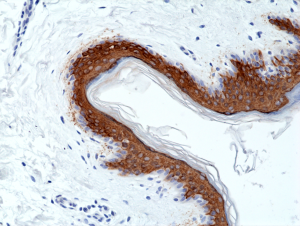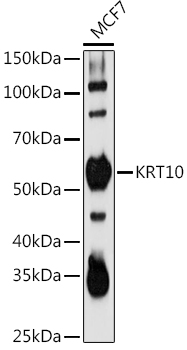
Immunohistochemical staining of formalin fixed and paraffin embedded human skin tissue section using anti-CK-10 rabbit monoclonal antibody (Clone RM386) at a 1:1000 dilution.
anti-Cytokeratin 10 (human), Rabbit Monoclonal (RM386)
REV-31-1272-00
ApplicationsWestern Blot, ImmunoHistoChemistry
Product group Antibodies
TargetKRT10
Overview
- SupplierRevMAb Biosciences
- Product Nameanti-Cytokeratin 10 (human), Rabbit Monoclonal (RM386)
- Delivery Days Customer10
- ApplicationsWestern Blot, ImmunoHistoChemistry
- CertificationResearch Use Only
- ClonalityMonoclonal
- Clone IDRM386
- Gene ID3858
- Target nameKRT10
- Target descriptionkeratin 10
- Target synonymsBCIE, BIE, CK10, EHK, EHK2, EHK2A, EHK2B, IHL, K10, KPP, keratin, type I cytoskeletal 10, CK-10, cytokeratin 10, keratin 10, type I
- HostRabbit
- IsotypeIgG
- Protein IDP13645
- Protein NameKeratin, type I cytoskeletal 10
- Scientific DescriptionCytokeratins are keratin proteins found in the intracytoplasmic cytoskeleton of epithelial tissue (at least 20 different polypeptides). They are an important component of intermediate filaments, which help cells resist mechanical stress. Expression of these cytokeratins within epithelial cells is largely specific to particular organs or tissues. The subsets of cytokeratins which an epithelial cell expresses depends mainly on the type of epithelium, the moment in the course of terminal differentiation and the stage of development. Thus a specific cytokeratin expression profile allows the identification of epithelial cells. Furthermore, this applies also to the malignant counterparts of the epithelia, (carcinomas). Cytokeratin subtype expression patterns are used to an increasing extent in the distinction of different types of epithelial malignancies. The cytokeratin antibodies are not only of assistance in the differential diagnosis of tumors using immunohistochemistry on tissue sections, but are also a useful tool in cytopathology and flow cytometric assays. Cytokeratin-10 (CK10) belongs to type I and acidic cytokeratin family. It is low molecular weight cytokeratin that is usually expressed in suprabasal keratinocytes and can also be seen in suprabasal cells of internal noncornifying, stratified squamous epithelia. CK10 is reported to be a typical component of cells of eccrine sweat gland ducts and sebaceous cells. CK10 is a target in the identification of well differentiated squamous cell carcinoma derived from skin or from internal organs and in the differentiation of extra-mammary Pagets disease (negative) from basal cell carcinoma and squamous cell carcinoma (positive). - Recombinant Antibody. This antibody reacts to Human CK-10. Applications: WB, IHC. Source: Rabbit. Liquid. 50% Glycerol/PBS with 1% BSA and 0.09% sodium azide. Cytokeratins are keratin proteins found in the intracytoplasmic cytoskeleton of epithelial tissue (at least 20 different polypeptides). They are an important component of intermediate filaments, which help cells resist mechanical stress. Expression of these cytokeratins within epithelial cells is largely specific to particular organs or tissues. The subsets of cytokeratins which an epithelial cell expresses depends mainly on the type of epithelium, the moment in the course of terminal differentiation and the stage of development. Thus a specific cytokeratin expression profile allows the identification of epithelial cells. Furthermore, this applies also to the malignant counterparts of the epithelia, (carcinomas). Cytokeratin subtype expression patterns are used to an increasing extent in the distinction of different types of epithelial malignancies. The cytokeratin antibodies are not only of assistance in the differential diagnosis of tumors using immunohistochemistry on tissue sections, but are also a useful tool in cytopathology and flow cytometric assays. Cytokeratin-10 (CK10) belongs to type I and acidic cytokeratin family. It is low molecular weight cytokeratin that is usually expressed in suprabasal keratinocytes and can also be seen in suprabasal cells of internal noncornifying, stratified squamous epithelia. CK10 is reported to be a typical component of cells of eccrine sweat gland ducts and sebaceous cells. CK10 is a target in the identification of well differentiated squamous cell carcinoma derived from skin or from internal organs and in the differentiation of extra-mammary Pagets disease (negative) from basal cell carcinoma and squamous cell carcinoma (positive).
- Storage Instruction-20°C
- UNSPSC12352203






